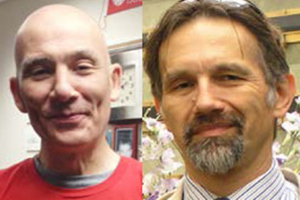Olcay Akman is a renegade.
You might not think it when you hear his job description—co-director of the biomathematics program at Illinois State. But Akman, a professor of mathematics, along with fellow director, Professor of Biology Steven Juliano, are taking the academic practices of the field, and turning them on their ear.
What began as a small graduate program at Illinois State in 2007, now boasts a national conference that draws big names in the field, and a brand new scholarly journal titled Letters in Biomathematics. The one thing you won’t find is “BioMath” doing things in a conventional way.
“Biomathematics is a fairly new field. You won’t hear stories of Galileo or the Greeks charging in to do biomath,” said Akman.
The field is exactly as it sounds—a marriage of the biological and mathematical disciplines. In his latest research, Akman is creating mathematical models to understand the spread of cholera in Zimbabwe and Haiti. He has also done work fashioning mathematical models to help farmers determine how much pesticide to purchase.
“Biomathematics is used on the medical side as well, helping determine outbreaks of infection and or optimal dosage in medicine,” said Akman.
BioMath kicked off at Illinois State as a University Program of Excellence. Unlike larger institutions, the program started with the idea of honoring the cross-disciplinary approach. “Ours is the only program where you can get a master’s in both biology and math through the program. It is truly parallel,” said Akman.
Soon after the program started, Akman came to Juliano with an idea for a conference – one that would counter all the frustrations he remembered as a young scholar. “You pay a huge registration fee for these huge national conferences, but if you are a graduate student or a new professor, you only get this tiny amount of time to speak. Only the ‘big shots’ get longer presentation times,” said Akman. “So we were basically a reaction to this.”
So came to life the Biomathematics and Ecology, Education and Research Conference, which they lovingly call BEER, in 2008. Planned by Akman, Juliano and colleagues from Benedictine University and Chicago State University, it steers away from parceling time depending on names. “At the BEER conference, you may be a big shot, or a graduate student, but you get 30 minutes. We all get the same time,” said Akman.
Also bucking the national trend, the BEER Conference dedicates equal time for education and research. “At most conferences, education is placed on a lower scale. Again, we allocate equal time,” said Akman.
The conference has been growing in strength and number since its inception six years ago. Taking turns on each coast and the Midwest, previous locations have included Portland, Washington, D.C., and St. Louis. More than 100 presenters presided in 2013’s event in Virginia at Marymount University. In 2015, the conference will head back to Illinois State.
Far from hindering big names from taking part, the unique approach has drawn leaders in the biomathematics field to the conference and the journal. “This has developed into something really meaningful in the field,” said Akman.
The new journal, Letters in Biomathematics, follows the same guidelines as the conference. Originally printed as a proceeding of the BEER Conference, the growing number of submissions prompted Akman to create a stand-alone publication. “It is very hard to get papers published in a timely fashion,” said Akman, who recalled waiting 18 months for a rejection when he was a young professor. “The dissemination of research is getting harder and harder. So, just as with the BEER Conference, we thought we should start an open-access journal with rapid turn-around for publications.”
Pointing to the newest round of articles, Akman said they also adhere to the balance between research and education. “So we do have research like Are Macrophages Our Friends or Enemies, but you will also find an article on a how to create a project-based modeling course,” he said.
Annual BEER soccer match pitting mathematicans against biologists.
For Akman, finding paths for mathematics and biology to connect remains key, especially in not-so-traditional ways. “Another rule for each conference is that the host has to organize a soccer match with mathematicians and biologists,” he said. “Yes, the goal is to provide a respectable and meaningful platform for the biomath community to disseminate knowledge. That doesn’t mean you can’t have fun doing it.”


